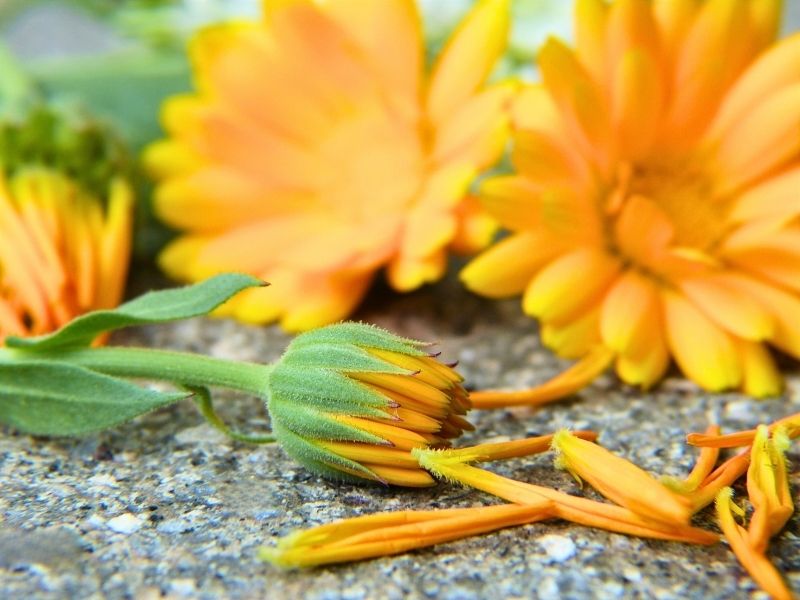
Calendula's Flower Power: food, medicine + beauty
European folklore associates Calendula with the Sun. It is said to strengthen and comfort the heart, soothe agitation, and draw out evil spirits. Who doesn't need more of that?
The sunshine connection is not surprising. Calendula's bright yellow and orange flowers mirror her warm, sunny personality. She's a friendly, cheerful plant that looks really lovely in all types of gardens.
Not only soothing for our psyches, Calendula has long been relied upon as healthy food, gentle medicine, and healing skin care.
Eat your medicine
Calendula's petals, leaves, and stem contain carotenoids which are vitamin A precursors with antioxidant activity.
Calendula's flavor is described as earthy, a little bitter, and with a dash of peppery. Drinking the tea may be an acquired taste but it's a nice tea.
To try Calendula in a more savory form, here's a rice dish I learned from Mother Earth News Magazine:
1 onion, diced
2 tsp olive oil
1 cup fresh Calendula petals
1 cup water
1/2 vegetable bouillon cube
1/2 cup of brown rice
Saute the onion in the olive oil in a small pot. Whiz up half of the Calendula petals in the cup of water in a blender, then pour the liquid over the onions. Add the bouillon cube, bring to a boil, then add the rice. Cover the pot and turn the heat down to simmer. Cook until the water is absorbed. When done, stir in the rest of the Calendula petals.
Home apothecary
Traditionally used to heal wounds, increase bile flow, and cleanse the lymph system, Calendula (Calendula officinalis) today is listed in German Commission E, European Scientific Co-operative on Phytotherapy, British Herbal Pharmacopoeia, and World Health Organization monographs for wound healing and anti-inflammatory actions.
Here's an incomplete list of its properties:
- antibacterial
- antifungal
- anti-inflammatory
- antiviral
- astringent
- demulcent
- diaphoretic
- vulnerary
It's the perfect herb to have on hand in the home apothecary. Calendula is very gentle, has many applications, and extracts well into water, aloe, vinegar, witch hazel, vegetable oils, and alcohol.
One of my go-to Calendula remedies is gargling with tea. It reduces inflammation of the mucous membranes of the mouth and throat, easing those grey weather-inspired sore throats.
Topical care
Calendula can be used topically at least a hundred and one ways (she says with no exaggeration). It's really helpful for cuts and scrapes, rashes, burns, and stings.
In the garden, rub fresh flowers into a bee sting to reduce the swelling and pain. For burns, make a compress by chopping the flowers and moistening with water.
Craft a salve with fresh or dried Calendula to use on all those little scrapes you get while gardening.
For skincare, it's excellent for all skin types and especially good for sensitive, dehydrated, dry, and chapped skin. Calendula improves skin’s condition by softening and smoothing skin, refining and reducing large pores and encouraging cell renewal.
(*Sustainability Suggestion: You can use the leaves and stems too in the skincare you make! You won't get the beautiful golden hue as when only the flowers are used, but you won't be wasting all that good plant material either.)
In the garden
Calendula is an annual herb that's easily grown from seed. Plant as soon as your ground can be worked in the Spring. It likes germinating in the cool weather.
Give Calendula a nice sunny area with rich soil. It makes a good companion in the veggie garden for Peas, Carrots, Asparagus, Cucumbers, and Tomatoes. The flowers attract pollinators and can repel unwanted insects like bean beetle and tomato worm.
Grows happily in pots too if you're tight on space.
(*Cautions: May cause an allergic reaction in people who are sensitive to the Asteraceae/Compositae family (ragweed and related plants). Don't use while pregnant.)
